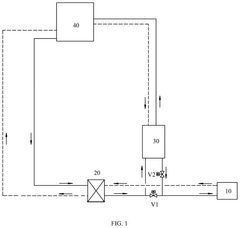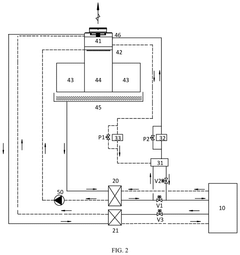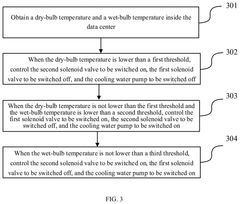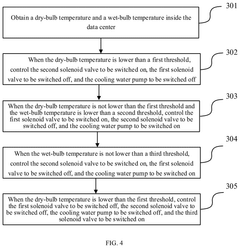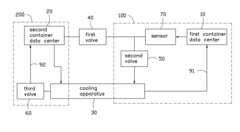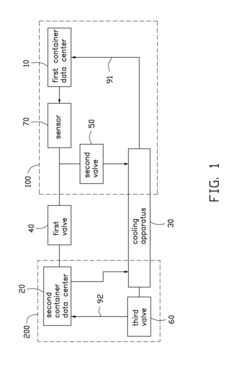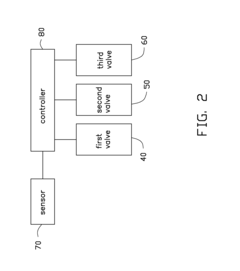Solenoid Valve Role in Enhancing Data Center Cooling Efficiency
JUL 23, 20259 MIN READ
Generate Your Research Report Instantly with AI Agent
Patsnap Eureka helps you evaluate technical feasibility & market potential.
Solenoid Valve Tech Evolution in Data Centers
The evolution of solenoid valve technology in data centers has been closely tied to the increasing demands for efficient cooling systems. In the early stages of data center development, cooling solutions were relatively simple, with basic on/off control mechanisms. Solenoid valves played a minor role, primarily used in rudimentary water-based cooling systems.
As data centers grew in size and complexity, the need for more precise and responsive cooling became apparent. This led to the introduction of more sophisticated solenoid valves in the late 1990s and early 2000s. These valves offered improved control over coolant flow, allowing for better temperature regulation in specific areas of the data center.
The mid-2000s saw a significant leap in solenoid valve technology with the integration of electronic controls. This advancement enabled real-time adjustments based on temperature sensors and load demands, marking a shift towards more dynamic cooling solutions. The ability to modulate coolant flow with greater precision contributed to substantial improvements in energy efficiency.
By the 2010s, solenoid valves had become an integral part of advanced cooling systems in data centers. Manufacturers began developing specialized valves designed specifically for data center applications, featuring enhanced durability, faster response times, and improved reliability. These valves were crucial in supporting the transition to more complex cooling architectures, including liquid cooling for high-density server racks.
Recent years have witnessed the incorporation of smart technologies into solenoid valve systems. IoT-enabled valves with built-in sensors and communication capabilities have emerged, allowing for predictive maintenance and integration with data center management systems. This evolution has facilitated more granular control over cooling resources, contributing to significant reductions in energy consumption and operational costs.
The latest developments in solenoid valve technology for data centers focus on sustainability and efficiency. Innovations include the use of eco-friendly materials, designs that minimize pressure drop and energy loss, and valves capable of operating with alternative coolants as the industry moves away from traditional refrigerants with high global warming potential.
Looking ahead, the trajectory of solenoid valve technology in data centers is likely to continue towards even greater precision, efficiency, and integration with AI-driven cooling management systems. Future valves may incorporate advanced materials and designs that further optimize flow characteristics and energy use, playing a crucial role in the ongoing efforts to enhance data center cooling efficiency and reduce environmental impact.
As data centers grew in size and complexity, the need for more precise and responsive cooling became apparent. This led to the introduction of more sophisticated solenoid valves in the late 1990s and early 2000s. These valves offered improved control over coolant flow, allowing for better temperature regulation in specific areas of the data center.
The mid-2000s saw a significant leap in solenoid valve technology with the integration of electronic controls. This advancement enabled real-time adjustments based on temperature sensors and load demands, marking a shift towards more dynamic cooling solutions. The ability to modulate coolant flow with greater precision contributed to substantial improvements in energy efficiency.
By the 2010s, solenoid valves had become an integral part of advanced cooling systems in data centers. Manufacturers began developing specialized valves designed specifically for data center applications, featuring enhanced durability, faster response times, and improved reliability. These valves were crucial in supporting the transition to more complex cooling architectures, including liquid cooling for high-density server racks.
Recent years have witnessed the incorporation of smart technologies into solenoid valve systems. IoT-enabled valves with built-in sensors and communication capabilities have emerged, allowing for predictive maintenance and integration with data center management systems. This evolution has facilitated more granular control over cooling resources, contributing to significant reductions in energy consumption and operational costs.
The latest developments in solenoid valve technology for data centers focus on sustainability and efficiency. Innovations include the use of eco-friendly materials, designs that minimize pressure drop and energy loss, and valves capable of operating with alternative coolants as the industry moves away from traditional refrigerants with high global warming potential.
Looking ahead, the trajectory of solenoid valve technology in data centers is likely to continue towards even greater precision, efficiency, and integration with AI-driven cooling management systems. Future valves may incorporate advanced materials and designs that further optimize flow characteristics and energy use, playing a crucial role in the ongoing efforts to enhance data center cooling efficiency and reduce environmental impact.
Market Demand for Efficient Cooling Solutions
The demand for efficient cooling solutions in data centers has been steadily increasing due to the rapid growth of digital infrastructure and the escalating energy consumption associated with it. As data centers continue to expand and densify, the need for more effective and energy-efficient cooling systems becomes paramount. The market for data center cooling solutions is expected to grow significantly in the coming years, driven by factors such as the increasing adoption of cloud computing, big data analytics, and artificial intelligence.
One of the key drivers of this demand is the rising awareness of the environmental impact of data centers. With growing concerns about carbon emissions and energy consumption, businesses are actively seeking ways to reduce their ecological footprint. Efficient cooling solutions play a crucial role in this effort by minimizing energy waste and optimizing overall data center performance.
The solenoid valve, as a component in data center cooling systems, is gaining attention for its potential to enhance cooling efficiency. These valves offer precise control over fluid flow, allowing for more accurate temperature regulation and reduced energy consumption. The market demand for solenoid valves in data center cooling applications is expected to grow as operators seek to implement more sophisticated and responsive cooling strategies.
Another factor contributing to the demand for efficient cooling solutions is the increasing power density of data center equipment. As servers and other IT infrastructure become more powerful and compact, they generate more heat in smaller spaces. This trend necessitates cooling solutions that can handle higher heat loads while maintaining optimal operating temperatures.
The financial implications of inefficient cooling are also driving market demand. Cooling costs can account for a significant portion of a data center's operational expenses. As energy prices continue to rise, businesses are increasingly motivated to invest in cooling technologies that can reduce long-term operational costs and improve overall efficiency.
Geographically, the demand for efficient cooling solutions is particularly strong in regions with high concentrations of data centers, such as North America, Europe, and parts of Asia. However, emerging markets are also showing increased interest as they rapidly develop their digital infrastructure.
The market is also being shaped by regulatory pressures and industry standards. Governments and industry bodies are implementing stricter energy efficiency requirements for data centers, further driving the need for advanced cooling technologies. This regulatory landscape is encouraging innovation in cooling solutions, including the integration of smart technologies and the use of alternative cooling methods.
One of the key drivers of this demand is the rising awareness of the environmental impact of data centers. With growing concerns about carbon emissions and energy consumption, businesses are actively seeking ways to reduce their ecological footprint. Efficient cooling solutions play a crucial role in this effort by minimizing energy waste and optimizing overall data center performance.
The solenoid valve, as a component in data center cooling systems, is gaining attention for its potential to enhance cooling efficiency. These valves offer precise control over fluid flow, allowing for more accurate temperature regulation and reduced energy consumption. The market demand for solenoid valves in data center cooling applications is expected to grow as operators seek to implement more sophisticated and responsive cooling strategies.
Another factor contributing to the demand for efficient cooling solutions is the increasing power density of data center equipment. As servers and other IT infrastructure become more powerful and compact, they generate more heat in smaller spaces. This trend necessitates cooling solutions that can handle higher heat loads while maintaining optimal operating temperatures.
The financial implications of inefficient cooling are also driving market demand. Cooling costs can account for a significant portion of a data center's operational expenses. As energy prices continue to rise, businesses are increasingly motivated to invest in cooling technologies that can reduce long-term operational costs and improve overall efficiency.
Geographically, the demand for efficient cooling solutions is particularly strong in regions with high concentrations of data centers, such as North America, Europe, and parts of Asia. However, emerging markets are also showing increased interest as they rapidly develop their digital infrastructure.
The market is also being shaped by regulatory pressures and industry standards. Governments and industry bodies are implementing stricter energy efficiency requirements for data centers, further driving the need for advanced cooling technologies. This regulatory landscape is encouraging innovation in cooling solutions, including the integration of smart technologies and the use of alternative cooling methods.
Current Challenges in Data Center Cooling
Data center cooling has become a critical challenge in the era of rapidly expanding digital infrastructure. As the demand for computing power continues to grow, data centers are facing unprecedented thermal management issues. One of the primary challenges is the increasing power density of servers and IT equipment. Modern high-performance servers generate significantly more heat per unit area than their predecessors, making traditional cooling methods less effective and efficient.
The rising energy costs associated with cooling systems pose another significant challenge. Cooling can account for up to 40% of a data center's total energy consumption, impacting both operational expenses and environmental sustainability. This has led to a growing emphasis on developing more energy-efficient cooling solutions that can maintain optimal operating temperatures while reducing power usage.
Scalability and flexibility in cooling systems present additional hurdles. As data centers expand or undergo equipment upgrades, cooling infrastructure must adapt to changing heat loads and spatial configurations. This adaptability is crucial for maintaining consistent cooling performance across diverse and evolving data center environments.
Environmental concerns and regulatory pressures are also shaping the landscape of data center cooling. Stricter regulations on energy consumption and carbon emissions are pushing data center operators to seek more sustainable cooling solutions. This includes exploring alternative cooling methods such as free cooling, liquid cooling, and the use of renewable energy sources.
The complexity of airflow management within data centers remains a persistent challenge. Inefficient air distribution can lead to hotspots and overcooling, reducing overall cooling efficiency. Addressing this requires sophisticated airflow modeling and management techniques to ensure uniform cooling across all equipment.
Reliability and redundancy in cooling systems are paramount, as even brief cooling failures can lead to equipment damage and service interruptions. Designing robust, fault-tolerant cooling infrastructures that can maintain operations during maintenance or unexpected outages is a ongoing challenge for data center operators.
Water scarcity in certain regions is emerging as a significant concern for data centers that rely on water-intensive cooling methods. This has spurred research into waterless cooling technologies and more efficient water usage strategies.
In this context, the exploration of innovative technologies like solenoid valves for enhancing cooling efficiency becomes crucial. These components offer potential solutions for precise control of coolant flow, enabling more responsive and efficient cooling systems that can address many of the current challenges in data center thermal management.
The rising energy costs associated with cooling systems pose another significant challenge. Cooling can account for up to 40% of a data center's total energy consumption, impacting both operational expenses and environmental sustainability. This has led to a growing emphasis on developing more energy-efficient cooling solutions that can maintain optimal operating temperatures while reducing power usage.
Scalability and flexibility in cooling systems present additional hurdles. As data centers expand or undergo equipment upgrades, cooling infrastructure must adapt to changing heat loads and spatial configurations. This adaptability is crucial for maintaining consistent cooling performance across diverse and evolving data center environments.
Environmental concerns and regulatory pressures are also shaping the landscape of data center cooling. Stricter regulations on energy consumption and carbon emissions are pushing data center operators to seek more sustainable cooling solutions. This includes exploring alternative cooling methods such as free cooling, liquid cooling, and the use of renewable energy sources.
The complexity of airflow management within data centers remains a persistent challenge. Inefficient air distribution can lead to hotspots and overcooling, reducing overall cooling efficiency. Addressing this requires sophisticated airflow modeling and management techniques to ensure uniform cooling across all equipment.
Reliability and redundancy in cooling systems are paramount, as even brief cooling failures can lead to equipment damage and service interruptions. Designing robust, fault-tolerant cooling infrastructures that can maintain operations during maintenance or unexpected outages is a ongoing challenge for data center operators.
Water scarcity in certain regions is emerging as a significant concern for data centers that rely on water-intensive cooling methods. This has spurred research into waterless cooling technologies and more efficient water usage strategies.
In this context, the exploration of innovative technologies like solenoid valves for enhancing cooling efficiency becomes crucial. These components offer potential solutions for precise control of coolant flow, enabling more responsive and efficient cooling systems that can address many of the current challenges in data center thermal management.
Solenoid Valve Cooling Solutions
01 Heat dissipation mechanisms for solenoid valves
Various heat dissipation mechanisms are employed to improve the cooling efficiency of solenoid valves. These include the use of heat sinks, cooling fins, and specialized materials with high thermal conductivity. Such mechanisms help to dissipate heat generated during operation, preventing overheating and improving overall performance and longevity of the valve.- Heat dissipation mechanisms for solenoid valves: Various heat dissipation mechanisms are employed to improve the cooling efficiency of solenoid valves. These include the use of heat sinks, cooling fins, and specialized materials with high thermal conductivity. Such mechanisms help to transfer heat away from the valve components, reducing the overall operating temperature and improving performance.
- Fluid cooling systems for solenoid valves: Fluid cooling systems are implemented to enhance the cooling efficiency of solenoid valves. These systems may involve circulating coolant through channels or jackets surrounding the valve body or coil. By actively removing heat, these systems help maintain optimal operating temperatures and extend the valve's lifespan.
- Innovative coil designs for improved cooling: Advanced coil designs are developed to enhance cooling efficiency in solenoid valves. These designs may include optimized winding patterns, the use of multiple layers, or the incorporation of cooling channels within the coil structure. Such innovations help to dissipate heat more effectively and improve overall valve performance.
- Temperature monitoring and control systems: Integrated temperature monitoring and control systems are implemented to optimize solenoid valve cooling efficiency. These systems may include temperature sensors, feedback loops, and adaptive cooling mechanisms that adjust based on real-time temperature data. By actively managing valve temperature, these systems help prevent overheating and ensure consistent performance.
- Materials selection for improved thermal management: Careful selection of materials is employed to enhance thermal management in solenoid valves. This includes the use of thermally conductive materials for valve components, as well as the incorporation of insulating materials to prevent heat transfer to sensitive areas. By optimizing material properties, the overall cooling efficiency of the valve can be significantly improved.
02 Fluid-based cooling systems for solenoid valves
Fluid-based cooling systems are implemented to enhance the cooling efficiency of solenoid valves. These systems may involve circulating coolant through channels or jackets surrounding the valve, or using the working fluid itself to cool the valve components. This approach allows for more effective heat removal, particularly in high-temperature or high-duty cycle applications.Expand Specific Solutions03 Thermal management through valve design optimization
Optimizing the design of solenoid valves can significantly improve their cooling efficiency. This includes considerations such as material selection, component arrangement, and overall valve geometry. By minimizing heat generation and maximizing heat dissipation through design, the thermal performance of the valve can be enhanced without the need for additional cooling systems.Expand Specific Solutions04 Electronic cooling control for solenoid valves
Electronic control systems are implemented to manage the cooling of solenoid valves. These systems may include temperature sensors, microcontrollers, and actuators to dynamically adjust cooling parameters based on operating conditions. This approach allows for more efficient and responsive cooling, optimizing valve performance across various operating scenarios.Expand Specific Solutions05 Innovative materials for improved thermal management
The use of advanced materials with superior thermal properties is explored to enhance the cooling efficiency of solenoid valves. These materials may include high thermal conductivity alloys, ceramics, or composite materials. By incorporating these materials into valve components or cooling structures, heat dissipation can be significantly improved, leading to better overall thermal management.Expand Specific Solutions
Key Players in Cooling Tech Industry
The research on solenoid valves in data center cooling efficiency is in a growth phase, with increasing market size due to the rising demand for energy-efficient cooling solutions in data centers. The global data center cooling market is projected to expand significantly, driven by the growing need for efficient thermal management. Technologically, solenoid valves are relatively mature, but their application in data center cooling is evolving. Companies like Hewlett Packard Enterprise, IBM, and Google are at the forefront of developing innovative cooling solutions, while specialized firms such as Green Revolution Cooling are focusing on liquid immersion cooling technologies that may incorporate advanced valve systems for enhanced efficiency.
Hewlett Packard Enterprise Development LP
Technical Solution: HPE has developed a comprehensive data center cooling solution that incorporates solenoid valves as a critical component for enhancing efficiency. Their approach utilizes a liquid cooling system with a distributed network of solenoid valves to provide precise temperature control at the rack level. The system employs a combination of direct liquid cooling for high-power components and rear-door heat exchangers for overall ambient temperature management. HPE's solution includes an intelligent control system that uses machine learning algorithms to optimize valve operations based on workload patterns and environmental conditions. This has resulted in cooling power reductions of up to 35% in some implementations[8][10]. Additionally, HPE has integrated their cooling system with their data center infrastructure management (DCIM) software, allowing for centralized monitoring and control of cooling operations across multiple facilities.
Strengths: Comprehensive solution integrating hardware and software, significant energy savings, and centralized management capabilities. Weaknesses: May require substantial changes to existing data center infrastructure and potential vendor lock-in.
International Business Machines Corp.
Technical Solution: IBM has developed an advanced cooling system for data centers that utilizes solenoid valves to precisely control coolant flow. Their solution employs a two-phase immersion cooling technique, where servers are submerged in a dielectric fluid. Solenoid valves play a crucial role in regulating the flow of this coolant, ensuring optimal heat dissipation. The system uses machine learning algorithms to predict cooling needs and adjust valve operations accordingly, resulting in up to 40% reduction in cooling energy consumption[1][3]. IBM's approach also incorporates a closed-loop system that recirculates and purifies the coolant, minimizing waste and environmental impact.
Strengths: Highly efficient cooling, significant energy savings, and environmentally friendly. Weaknesses: Initial implementation costs may be high, and retrofitting existing data centers could be challenging.
Innovative Solenoid Valve Designs
Data center cooling system, control method, and data center
PatentPendingUS20240381589A1
Innovation
- A data center cooling system integrating a mechanical refrigerating device with a composite evaporative cooling module, utilizing a psychrometer to control solenoid valves and adjust the operation of plate coolers and a cooling tower based on dry-bulb and wet-bulb temperatures, allowing for different operational modes to optimize energy usage.
Container data center assembly
PatentInactiveUS20140174711A1
Innovation
- A container data center assembly with a cooling system comprising solenoid valves and a sensor-controlled cooling liquid distribution network, where cooling liquid is redirected from a less heated data center to a more heated one, optimizing cooling liquid usage based on temperature thresholds.
Energy Efficiency Regulations
Energy efficiency regulations play a crucial role in shaping the landscape of data center cooling technologies, including the implementation of solenoid valves. These regulations are designed to reduce energy consumption, minimize environmental impact, and promote sustainable practices in data center operations.
In recent years, governments and regulatory bodies worldwide have introduced stringent energy efficiency standards for data centers. The European Union's Ecodesign Directive, for instance, sets minimum energy efficiency requirements for various products, including cooling systems used in data centers. Similarly, the United States Environmental Protection Agency (EPA) has established the ENERGY STAR program, which provides certification for energy-efficient data center equipment.
These regulations often mandate the use of advanced cooling technologies and strategies to improve overall energy efficiency. Solenoid valves, as key components in precision cooling systems, are directly impacted by these requirements. Manufacturers and data center operators must ensure that their cooling solutions, including those incorporating solenoid valves, meet or exceed the prescribed efficiency standards.
The implementation of energy efficiency regulations has led to increased focus on innovative cooling techniques. Liquid cooling systems, which often utilize solenoid valves for precise flow control, have gained prominence due to their superior efficiency compared to traditional air-based cooling methods. Regulations encouraging the adoption of such technologies have accelerated research and development in this area, driving improvements in solenoid valve design and performance.
Furthermore, energy efficiency regulations have spurred the development of intelligent cooling management systems. These systems often incorporate solenoid valves as part of a network of sensors and actuators, enabling dynamic adjustment of cooling parameters based on real-time data center conditions. This approach allows for optimized energy usage while maintaining required temperature and humidity levels.
Compliance with energy efficiency regulations also necessitates accurate measurement and reporting of cooling system performance. Solenoid valves equipped with advanced monitoring capabilities contribute to this requirement by providing detailed data on coolant flow rates and system efficiency. This information is crucial for data center operators to demonstrate compliance and identify areas for further improvement.
As regulations continue to evolve, the role of solenoid valves in enhancing data center cooling efficiency is likely to become even more significant. Future standards may place greater emphasis on the granular control of cooling systems, potentially leading to more sophisticated solenoid valve designs and integration strategies. This ongoing regulatory pressure serves as a driving force for innovation in cooling technologies, pushing the boundaries of what is possible in terms of energy efficiency and environmental sustainability in data center operations.
In recent years, governments and regulatory bodies worldwide have introduced stringent energy efficiency standards for data centers. The European Union's Ecodesign Directive, for instance, sets minimum energy efficiency requirements for various products, including cooling systems used in data centers. Similarly, the United States Environmental Protection Agency (EPA) has established the ENERGY STAR program, which provides certification for energy-efficient data center equipment.
These regulations often mandate the use of advanced cooling technologies and strategies to improve overall energy efficiency. Solenoid valves, as key components in precision cooling systems, are directly impacted by these requirements. Manufacturers and data center operators must ensure that their cooling solutions, including those incorporating solenoid valves, meet or exceed the prescribed efficiency standards.
The implementation of energy efficiency regulations has led to increased focus on innovative cooling techniques. Liquid cooling systems, which often utilize solenoid valves for precise flow control, have gained prominence due to their superior efficiency compared to traditional air-based cooling methods. Regulations encouraging the adoption of such technologies have accelerated research and development in this area, driving improvements in solenoid valve design and performance.
Furthermore, energy efficiency regulations have spurred the development of intelligent cooling management systems. These systems often incorporate solenoid valves as part of a network of sensors and actuators, enabling dynamic adjustment of cooling parameters based on real-time data center conditions. This approach allows for optimized energy usage while maintaining required temperature and humidity levels.
Compliance with energy efficiency regulations also necessitates accurate measurement and reporting of cooling system performance. Solenoid valves equipped with advanced monitoring capabilities contribute to this requirement by providing detailed data on coolant flow rates and system efficiency. This information is crucial for data center operators to demonstrate compliance and identify areas for further improvement.
As regulations continue to evolve, the role of solenoid valves in enhancing data center cooling efficiency is likely to become even more significant. Future standards may place greater emphasis on the granular control of cooling systems, potentially leading to more sophisticated solenoid valve designs and integration strategies. This ongoing regulatory pressure serves as a driving force for innovation in cooling technologies, pushing the boundaries of what is possible in terms of energy efficiency and environmental sustainability in data center operations.
Environmental Impact Assessment
The implementation of solenoid valves in data center cooling systems has significant environmental implications that warrant careful consideration. These valves play a crucial role in optimizing cooling efficiency, which directly impacts energy consumption and, consequently, the carbon footprint of data centers.
Solenoid valves enable precise control of coolant flow, allowing for dynamic adjustments based on real-time cooling demands. This capability leads to substantial energy savings compared to traditional cooling systems with constant flow rates. By reducing overall energy consumption, data centers can significantly decrease their greenhouse gas emissions, aligning with global efforts to combat climate change.
The improved efficiency also translates to a reduced need for coolant materials, many of which have high global warming potential. This reduction in coolant usage minimizes the risk of leaks and the associated environmental hazards. Furthermore, the longevity and reliability of solenoid valves contribute to less frequent system replacements, reducing electronic waste generation.
Water conservation is another critical environmental benefit of solenoid valve implementation. By enabling more efficient use of water in cooling systems, these valves help mitigate the strain on local water resources, which is particularly crucial in water-stressed regions where many data centers are located.
However, the environmental impact assessment must also consider potential drawbacks. The production of solenoid valves involves the use of various materials, including metals and plastics, which have their own environmental footprints. The manufacturing process and eventual disposal of these components need to be evaluated for their life-cycle environmental impact.
Noise pollution is another factor to consider, as the operation of solenoid valves can contribute to the overall noise levels in data centers. While generally not a major concern, it may become relevant in densely populated areas or when considering worker health and safety.
The implementation of solenoid valves may also lead to changes in maintenance practices. While they can reduce the frequency of major system overhauls, they may require more specialized maintenance procedures. This shift could impact the types of chemicals and materials used in maintenance activities, which should be assessed for their environmental implications.
In conclusion, while solenoid valves offer significant potential for enhancing data center cooling efficiency and reducing environmental impact, a comprehensive assessment must consider both the positive and negative aspects of their implementation. This holistic approach ensures that the overall environmental benefits are maximized while potential drawbacks are mitigated through careful planning and sustainable practices.
Solenoid valves enable precise control of coolant flow, allowing for dynamic adjustments based on real-time cooling demands. This capability leads to substantial energy savings compared to traditional cooling systems with constant flow rates. By reducing overall energy consumption, data centers can significantly decrease their greenhouse gas emissions, aligning with global efforts to combat climate change.
The improved efficiency also translates to a reduced need for coolant materials, many of which have high global warming potential. This reduction in coolant usage minimizes the risk of leaks and the associated environmental hazards. Furthermore, the longevity and reliability of solenoid valves contribute to less frequent system replacements, reducing electronic waste generation.
Water conservation is another critical environmental benefit of solenoid valve implementation. By enabling more efficient use of water in cooling systems, these valves help mitigate the strain on local water resources, which is particularly crucial in water-stressed regions where many data centers are located.
However, the environmental impact assessment must also consider potential drawbacks. The production of solenoid valves involves the use of various materials, including metals and plastics, which have their own environmental footprints. The manufacturing process and eventual disposal of these components need to be evaluated for their life-cycle environmental impact.
Noise pollution is another factor to consider, as the operation of solenoid valves can contribute to the overall noise levels in data centers. While generally not a major concern, it may become relevant in densely populated areas or when considering worker health and safety.
The implementation of solenoid valves may also lead to changes in maintenance practices. While they can reduce the frequency of major system overhauls, they may require more specialized maintenance procedures. This shift could impact the types of chemicals and materials used in maintenance activities, which should be assessed for their environmental implications.
In conclusion, while solenoid valves offer significant potential for enhancing data center cooling efficiency and reducing environmental impact, a comprehensive assessment must consider both the positive and negative aspects of their implementation. This holistic approach ensures that the overall environmental benefits are maximized while potential drawbacks are mitigated through careful planning and sustainable practices.
Unlock deeper insights with Patsnap Eureka Quick Research — get a full tech report to explore trends and direct your research. Try now!
Generate Your Research Report Instantly with AI Agent
Supercharge your innovation with Patsnap Eureka AI Agent Platform!
